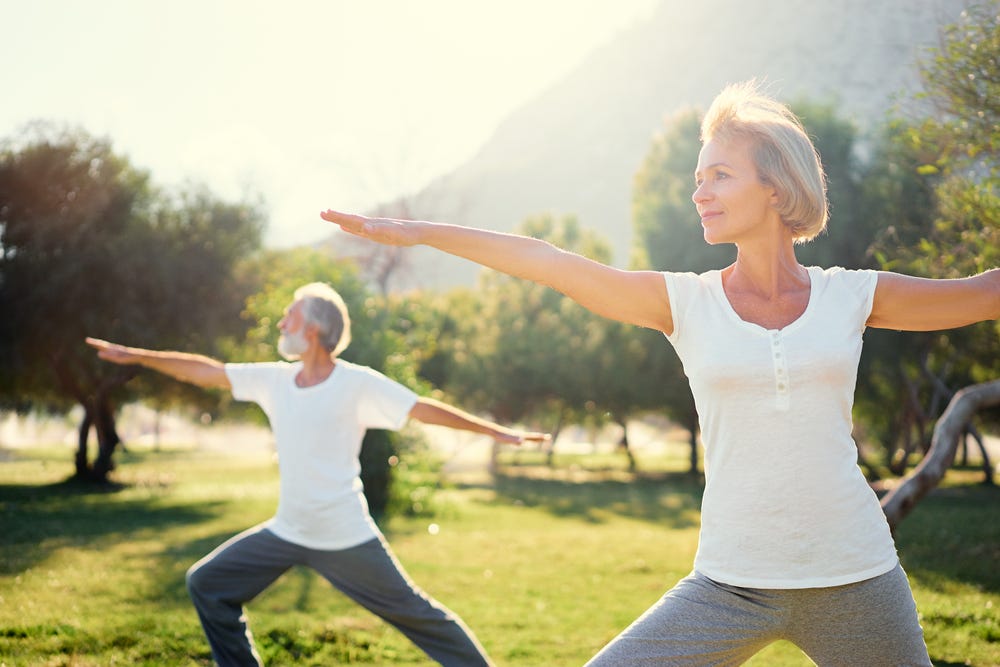
Routine exercise is good for people of all ages. But staying active at 55 and beyond also helps combat some of the natural physical changes that occur as we get older. If thoughts of complex workouts or costly gym memberships seem daunting, don’t worry! Simply getting up and moving throughout the day to break up long periods of sitting or lounging is an excellent step in a healthier direction.
According to the Mayo Clinic, incorporating physical activity into daily routines can improve heart health, boost energy, reduce stress, strengthen bones and muscles, and enhance brain function. Follow these active aging tips and start maximizing your health and wellness while achieving your fitness goals!|
Note: It’s important to consult your doctor to discuss any potential limitations, risks, or restrictions you have before you begin a new or updated exercise routine.
Start Slowly
For optimum health benefits, the U.S. Department of Health and Human Services recommends doing 150 to 300 minutes of moderate-intensity aerobic activity and two days of muscle-strengthening workouts per week. However, it’s important to start new exercises slowly - especially if you’ve been sedentary for a while. In other words, don’t enter a 5K race if you’ve never jogged a mile! It’s okay to start exercising for just 10 minutes a day. Taking baby steps can help prevent injuries and lead to maintaining a healthier lifestyle. Overall, moving frequently and sticking with a fitness plan is what matters.
Walking Does Wonders
Walking is one of the easiest ways to get in shape. Walking works heart muscles, helps with weight loss, and can brighten your mood. According to an International Journal of Behavioral Nutrition and Physical Activity study, healthy older adults should take anywhere from 2,000 to 9,000 steps a day. Wondering how to fit these steps in? At home, make multiple trips up and down the hall, do laps around your kitchen, or walk up and down the basement stairs several times a day. To get some fresh air and enjoy a change of scenery, take your dog for a walk, stroll through the park, hunt for beach treasures with a metal detector, or go on a brisk walk through the neighborhood. Walking with a friend or family member (socially-distant, of course!) can also be a fun way to connect with others, relieve stress, and make every step count.
Cardio is Critical
Aerobic activities that increase your heart rate can lower blood pressure and reduce the risk of cardiovascular disease. Therefore, cardio exercises are a critical part of any fitness program.
Pedaling a stationary bike, cycling, swimming, jogging, or playing tennis are just a few heart-healthy activities that help combat aging’s adverse effects. Hiking, dancing, and water aerobics are also fun options!

Photo by Deborah Kolb/Shutterstock
Building Strength Has Benefits
You don’t have to do bench presses at the gym to build muscles. Lifting a basic set of hand weights or even cans of soup from the pantry at home at least twice a week strengthens your arms. Other exercises like squats build leg muscles, and rowing simulations strengthen your back.
Doing 10 to 15 reps of these strengthening exercises is a good starting point. To challenge yourself, add more weight, and increase reps when your routine starts to feel too comfortable. Building strength naturally increases endurance - the more physical activity you enjoy, the stronger (and healthier) you’ll be.
Household Chores Enhance Health
If you dread housework, you’re not alone. However, the upside to performing an endless list of rotating tasks like gardening, raking leaves, vacuuming, and washing windows is that these everyday household chores keep you active! Check off these to-do items and keep yourself moving, stretching, bending, and exerting energy - you’re burning calories and, more importantly, staying active.
Balance Boosts Brain Function
Balancing exercises, such as standing on one leg, can sharpen neurological functions that decline with age. Getting up and down from the floor, sitting cross-legged, or walking with a book on your head also promotes flexibility and coordination.
Finally, you’re never too old to learn something new! Try boosting your brainpower by picking up a new hobby like bird watching, geocaching, or ballroom dancing. Overall, blending exercise with recreational activities can make actively aging fun!




